This was published 1 year ago
Line, space, repeat: The divine madness in this artist’s abstract patterns
At 82, Australian abstract artist Lesley Dumbrell’s retrospective, Thrum, is long overdue.
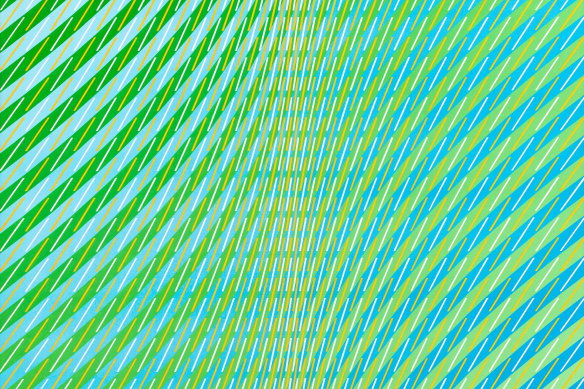
Lesley Dumbrell’s Foehn (1975), Liquitex on canvas.Credit: Lesley Dumbrell
Patrick Heron, one of Britain’s most prominent abstract artists, told me he lost his job as art critic at The New Statesman for writing too much about “space”. It may have bored the readers rigid, but for Heron space was a colossally exciting topic. It probably takes an artist to understand the thrill of seeing a large plane of recessive colour balanced by a small patch of brightness, or to feel the way an expanse of blue or red or yellow has an almost visceral impact on the viewer. “Edges” were especially stimulating, although it proved difficult to convey that feeling to the average reader.
I thought of Patrick’s heroic attempts to convince the public that large, colourful, abstract paintings were revolutionary gestures when looking at Lesley Dumbrell: Thrum at the Art Gallery of NSW. At the age of 82, Dumbrell is overdue for a retrospective. The only surprise is that it’s in Sydney, not her hometown of Melbourne. We’ve become accustomed to Melbourne staging retrospectives of Sydney artists, but the tables have been turned – largely, one suspects, because of the personal enthusiasm of curator Anne Ryan.
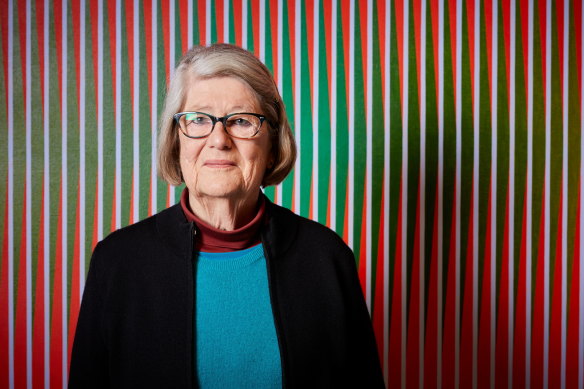
Dumbrell, 82, with her artwork Solstice (1974)Credit: Art Gallery of NSW/Jenni Carter
In the catalogue, there’s a substantial discussion of Dumbrell’s involvement in the Feminist movement of the 1970s and ’80s that did much to raise the profile of women artists. This is an important aspect of Dumbrell’s story, but although she may have been a dedicated feminist it would be a stretch to say she made feminist art. Her paintings are uncompromisingly abstract, from the grids and pattern works of the late 1960s to the laser-cut, sculptural pieces she produces today.
Dumbrell is another artist who felt the excitement of pure form: of lines, planes, edges, colour, pattern and space. All the action happens on the retina, as we allow our eyes to be swept back and forth across the canvas, responding to an array of visual effects. The expressive title of the show, Thrum, alludes to the sensations of rhythm and movement Dumbrell creates.
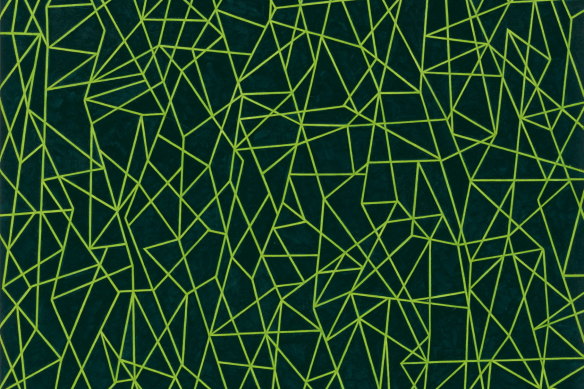
Lesley Dumbrell’s Chartreuse (2015), oil on canvas.Credit: Lesley Dumbrell/Art Gallery of NSW
Although there is a distinct upward and downward movement in Foehn (1975), such a work is an exception to the general rule. Dumbrell’s preference is for all-over grids and patterns without an obvious focal point. Ryan writes how the discovery of Bridget Riley’s Op Art proved inspirational for Dumbrell, as it “removed the ‘problem’ of composition through the repetition or variation of an element or elements, a liberating concept that soon defined her methods”.
This concentration on immersive pattern is both a strength and a limitation. It creates a standard of perfection that sees the artist covering every centimetre of the canvas with the same repeated motif. We marvel at Dumbrell’s patience and dexterity, as she lays down lines and tiny areas of colour with geometric precision.
In works such as Study for ‘Solstice’ (1974) or Capricorn (1975), there’s a kind of visual shudder, as if a wave was unfurling as we walk past. In later paintings such as Taffetas (1983) or Tramontana (1984), there’s a flickering or pulsing sensation, as we stand in front of a work taking in bright and dark patches of colour. In later paintings, the canvas may be covered with a fine mesh of criss-crossing lines drawn with machine-like exactitude.
There’s always something impressive about “the spectacle of skill” in art, to borrow the title of Robert Hughes’ final book. But there’s also a feeling of hollowness that attaches itself to form without content.
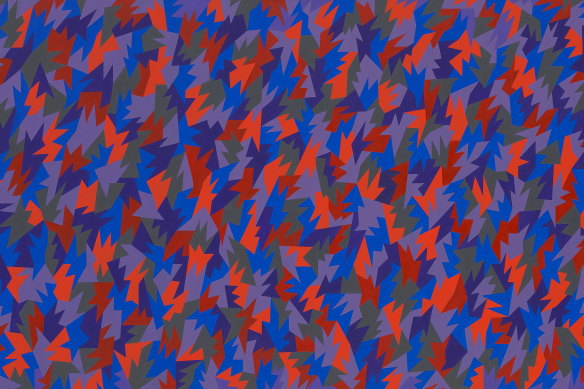
Lesley Dumbrell’s Tramontana (1984), Liquitex on canvasCredit: Lesley Dumbrell/National Gallery of Victoria
I’d much prefer to look at the most oblique abstraction by Lesley Dumbrell than another politically charged artwork that tells me the right attitudes to adopt. But while not wanting to send messages, she has made a prison cell for herself in which each series evolves within a strict set of boundaries.
Her methods are so disciplined it counts as a major breakthrough when she switches from Liquitex to oils or begins to fracture some of the lines of an all-over grid in Chartreuse (2015). Some, like the White Queen in Alice in Wonderland, may be willing to countenance six impossible things before breakfast, but Dumbrell has moved slowly and cautiously during a career of almost 60 years.
This may be because true abstraction is a virtual impossibility. Whatever the artist’s intentions, our brains are hard-wired to seek out concrete references. On the most basic level, a vertical panel suggests a figure and a horizontal one a landscape, even if there’s nothing on the canvas but a single colour.
Dumbrell’s works, with their busy, active surfaces, are strongly aligned with the natural world. She freely admits that landscape is her greatest inspiration, to the point of occasionally painting en plein air. She strives to capture impressions of light and atmosphere, albeit in a highly abstracted manner.
The largest work in the show, the triptych February (1976), evokes the changes of daylight during a summer’s day in Melbourne, with the bright glow of sunrise giving way to a pale blue sky and ending in the rosy tones of dusk. There’s also a persistent allusion to music, with the triptych being structured like a symphony in three distinct movements.
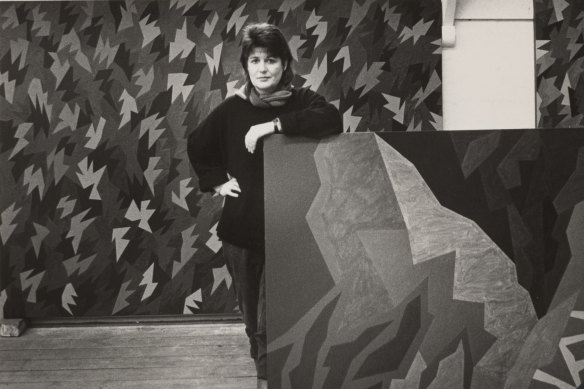
Dumbrell in her Richmond studio in the 1980s.Credit: David Moore
In 1989, in a quirk of fate, Dumbrell met and re-connected with the husband she had left in 1965. When the couple moved to Bangkok the following year, she had to overcome a severe culture shock to settle into the routines of studio work. The wildly different environment would affect Dumbrell’s painting, most obviously in the density and clarity of her line work. In 2000, the couple would purchase a property in the Strathbogie Ranges, and now divide their time between Thailand and the Victorian countryside.
For the viewer, it’s interesting to trace how these geographical relocations are reflected in Dumbrell’s work. Perhaps most surprising is that there was no radical break with the grids and lines to which she has become accustomed. To go from Melbourne to Bangkok is a major upheaval, and although Dumbrell seems to have felt the ripples in her use of line and colour, she has never strayed too far from the path she established at the end of the ’60s.
If there were an award for consistency in Australian art, Dumbrell would be hard to beat. Early in her career, she settled on a style and a method that suited her temperament. She’s stuck to those precepts with fierce determination. Although nothing may seem less personally revealing than a procession of abstract grids, it adds up to a portrait of a severely rational mind, a personality that values order, stability and routine.
In Benjamín Labatut’s novel The Maniac, it’s claimed that modern art “recognised no laws, no method. No truth, just a blind, uncontainable surge, a rush of madness that would not stop for anyone or anything but drive us onward even to the ends of the Earth”.
There’s an element of truth in this, even when one considers the cerebral nature of so much modern art. In Dumbrell’s work, there has been a lifelong effort to tame that “surge”, channelling it into tight geometric forms in which the smallest hint of Plato’s ‘divine madness’ may still be detected. Order and pattern taken to extremes begin to feel excessive and irrational. The very need to keep translating light and landscape into abstract form might be seen as a strange obsession.
Ultimately, the artist becomes a dancer who keeps swaying and moving to a set of rhythms replayed endlessly in her mind. To the viewer, she holds out the invitation to tune in to the same frequency.
Lesley Dumbrell: Thrum is at the Art Gallery of NSW until October 13.
To read more from Spectrum, visit our page here.